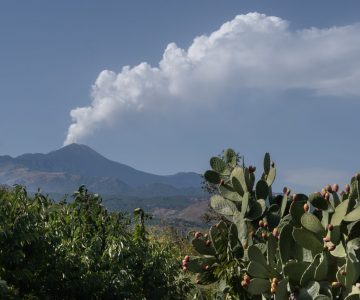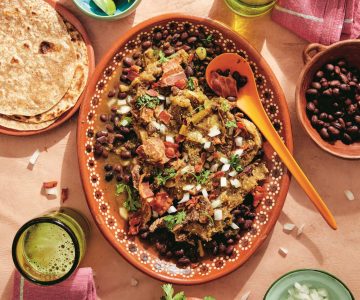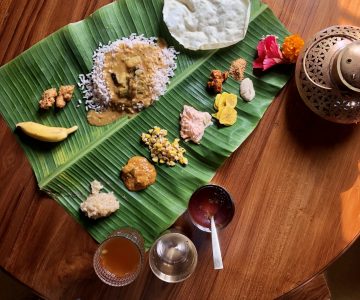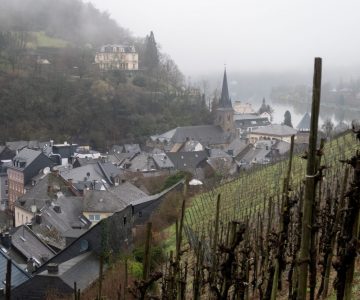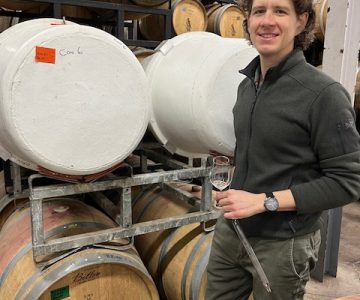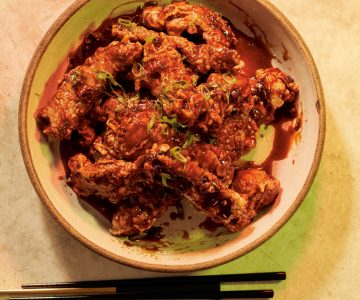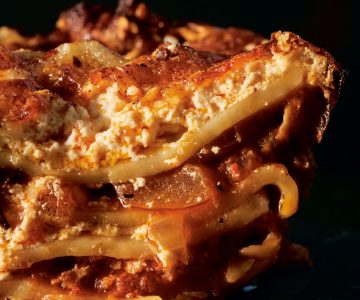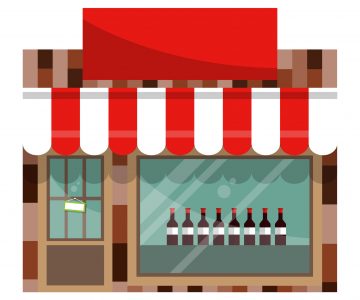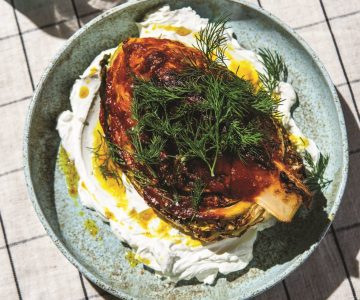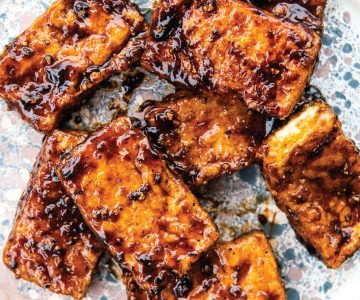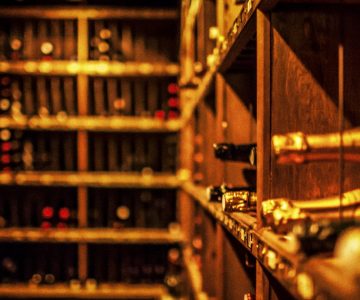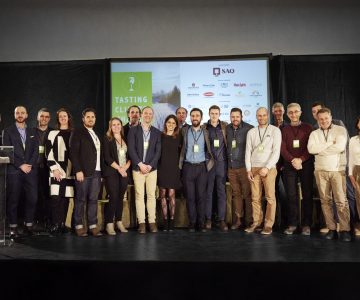While I have always found Bordeaux fascinating, I don’t think I have ever really fallen completely in love with wines from this region. Many of them are fussy and need a long time in a decanter before they are ready to give up their true aromas and flavours. Many of them are also crazy expensive … and out of reach for the average consumer. In effect, Bordeaux has become the high-maintenance friend we don’t invite to the party anymore. Can you really blame anyone for ignoring this premier cru region in 2018? Especially given that you can grab outstanding Cabernet Sauvignon from California for around 20 dollars. And how about Malbec from South America? Of course, I realize that by looking at these examples, we’re not talking about the skill of assemblage.
My comments about Bordeaux aside, I know Canada makes great wines from Merlot, Cabernet Sauvignon and Cabernet Franc. And, in recent years, we have been seeing Malbec and Petit Verdot making appearances in the vineyards of Ontario. Trius Red has long been a staple in my home and (to keep it simple) it’s a delicious wine. It turns out you don’t need to blast these grapes with intense California sunshine to unlock their delicious flavours.
On a trip to Niagara in December 2017, I found myself staring into a glass of 2015 Locked and Loaded from Rosewood and asking, “Why the hell am I not drinking more of this?” What I was looking at was a rich, fruity and concentrated wine that offered something you could serve next to roast beef. At 20 dollars a bottle, this wine was offering so much — it was immediately accessible and fruity. And there was nice depth and structure in the glass. You could stock up on a few bottles and save them for a rainy day in three or five years, or maybe more.
A few months later, on yet another trip, I was sitting in the tasting room at Fielding Estates, having another experience where I was asking myself the same question. It was clear that I hadn’t learned anything. In my glass was the 2016 Rockpile Red, a beautiful, fruity wine made from 50 percent Cabernet Franc and 50 percent Merlot. Its 25-dollar price tag surprised me. This wine is not delicate, but it’s also not brooding and heavy. It’s fruity and smoky, with very soft tannins. Another bottle that you can open in its youth without guilt (or a decanter) — or, with a little patience and restraint, you could squirrel away a few bottles for a rainy day.
At this point, it was clear to me that I had forgotten about some of the finest wines in the province. If I look back at the point where I fell in love with Ontario wine, I remember digging into bottles of 2004 Showcase Cabernet Sauvignon from Hillebrand (Trius). Many Ontario wineries, such as Stratus, Two Sisters, Trius and Megalomaniac, routinely charge north of 40 or even 50 dollars for their reserve bottles of Cabernet Sauvignon or Merlot, regardless of the growing conditions. I was worried that my love of Ontario Cabernet/Merlot might be in jeopardy and moving into the same category as Bordeaux. So, after my experiences at Fielding and Rosewood, I needed to see if their wines were the exception or the rule. I can’t really say that I was surprised by my findings, but I was thrilled to discover a bevy of new bottles that you will find in my house with renewed regularity.
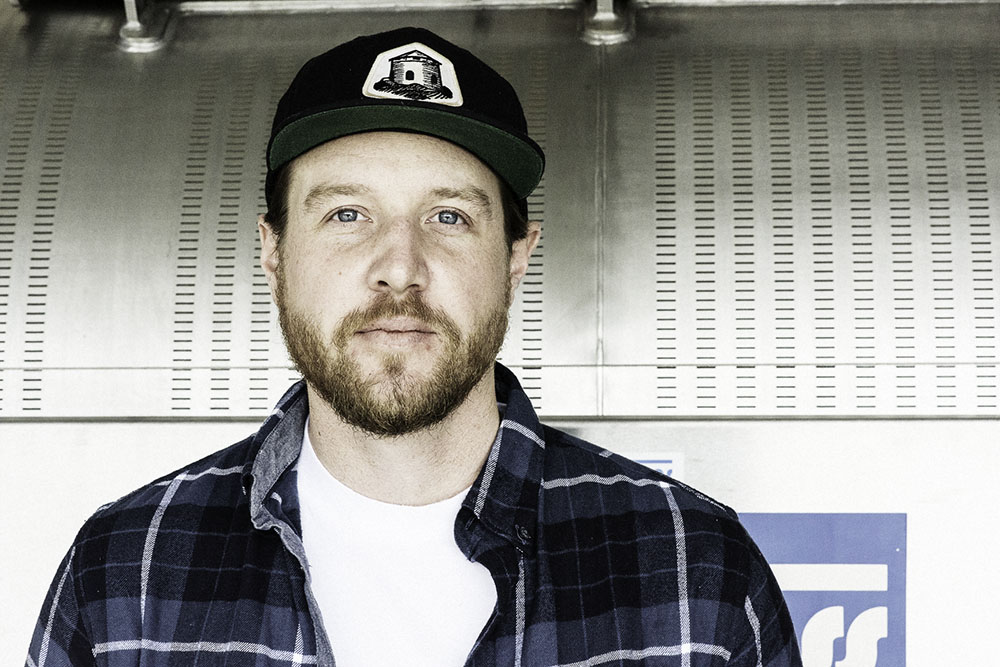
Reif Estate Cabernet Merlot 2016 ($15)
I realize it comes in a few dollars south of the $20 price point I set for myself, but this bottle holds up. It’s a nice reminder that Cab Merlot doesn’t need to be big and bold. You will find a nice vanilla note that embraces raspberry and cherry on the nose and on the palate. The tannins are soft and this wine is gulpable now. Put this easy-drinking wine on the table next to pizza or a burger.
Creekside Cabernet Merlot 2016 ($15)
Your quintessential barbecue wine. It’s unpretentious and straight-up easy to drink. The aromas and flavours are blackberry and cassis, caressed by a nice vanilla note. The tannins are very soft, resulting in easy drinking. Match this wine to burgers, steak, pizza or pasta with tomato-based sauces.
Frogpond Farm Organic Cabernet Merlot 2012 ($24)
A little rough around the edges but ready to drink now if you like a wine that shows a bit of age. The aromas are blueberry and raspberry, which are starting to dry out. There is also a slightly funky note that adds to the interest of this bottle. On the palate, the drying fruit is met with a nice cocoa note. And there is a hint of bell pepper that pokes through on the finish, reminding you that the Cabernet in this bottle includes Franc.
Pillitteri Estates Cabernet Merlot 2015 ($17)
I genuinely enjoyed this wine right to its core. It may be a little unfair to suggest drinking this bottle right now, since it may have some aging potential, but it checks too many boxes to be locked up. The aromas and flavours have a nice vanilla note layered over cherry and strawberry. There is a hint of red pepper on the finish of this wine, but it’s satisfying and well integrated under all the ripe fruit flavours.
Kacaba Vineyards Cabernet 2015 ($16)
A blend of Cabernet Franc and Cabernet Sauvignon. The Franc is unapologetic in announcing its presence in your glass with a soft, savoury note of red pepper mingling with smoke and red fruit. On the palate, the ripe fruit opens up with raspberry, cherry and blackberry. The finish is soft and easy.
Kacaba Vineyards Cabernet 2016 ($16)
Another bottle where it may be unfair to suggest that this isn’t something to hold onto for a few years. But it’s so approachable now that it’s not something I would worry about holding onto. The aromas are black liquorice, wood smoke, baking spice, cassis and black fruit. On the palate, this wine offers cassis, blackberry, dark cherry and plum. The tannins are soft and this wine is dangerously easy to drink.
The Foreign Affair Conspiracy 2015 ($18)
A blend of 54% Cabernet Franc, 28% Cabernet Sauvignon and 13% Merlot. This wine isn’t quite Bordelais at heart but rather a marriage between Niagara and Veneto. It’s made in a ripasso style, helping to pump up the flavours in this bottle. The fruit here moves into stewed with concentrated raspberry, blackberry and plum. There is also a cocoa note that pokes through on the finish. The tannins are soft and plush — this wine is ready to drink now.
13th Street Cabernet Merlot 2016 ($20)
The summer of 2016 is firmly in the rear-view mirror, and it feels like we have suffered from the weather ever since. Do not despair: some of that summer has been captured in this bottle. This blend of Cabernet Sauvignon and Merlot brings raspberry, strawberry and ripe red cherry to the nose and the palate. This wine is definitely driven by fruit flavours but they are met with cedar and cocoa notes as you get deeper into the glass and bottle.
Fielding Estate Winery Rockpile Red 2016 ($25)
A blend of 50% Cabernet Franc and 50% Merlot. I want to call this wine “almost” full-bodied since there is some nice restraint here. The fruit is rich and concentrated with raspberry, strawberry, cherry and cassis. On the palate, a nice cocoa note opens up and is met with silky tannins. This wine is approachable and easy drinking from the onset, but it could easily develop nicely in the cellar for a decade, maybe longer. That being said, it would be a shame to let the vibrant fruit dry out as this wine is practically begging to be enjoyed in its youth.
Rosewood Estates Winery Locked and Loaded Red 2015 ($20)
A blend of 43% Merlot, 27% Cabernet Sauvignon, 19% Cabernet Franc and 11% Malbec. This wine is the little brother of Rosewood’s Lock, Stock and Barrel, but there is nothing little about this wine. Aromas of vanilla, smoke, raspberry, blackberry and black currant climb out of the glass with nice intensity. The flavours match the nose and the tannins are velvet smooth and approachable now. That said, if you decide to stow a few bottles away for 5–7 years, this wine should cellar with ease. The smoky note has me thinking of opening a bottle as a reward for sitting next to a brisket for a 12-hour smoke.
Rosewood Estates Winery Locked and Loaded Red 2016 ($20)
The blend from this vintage is 34% Merlot, 27% Malbec, 20% Cabernet Franc, 14% Cabernet Sauvignon and 5% Petit Verdot. Given that 2016 was an unusually hot and dry summer, it’s remarkable the amount of restraint this bottle contains. The aromas are plum, cassis, blackberry and raspberry, with a hint of meatiness. On the palate, it is immediately smooth and soft — the texture is the real story behind this wine. The fruit on the palate is rich and juicy, but not cooked. The flavours match the nose but a strong blueberry note gets added to the party. In spite of how immediately approachable this wine is, it definitely has the ability to evolve nicely in a cellar for 5–7 years.
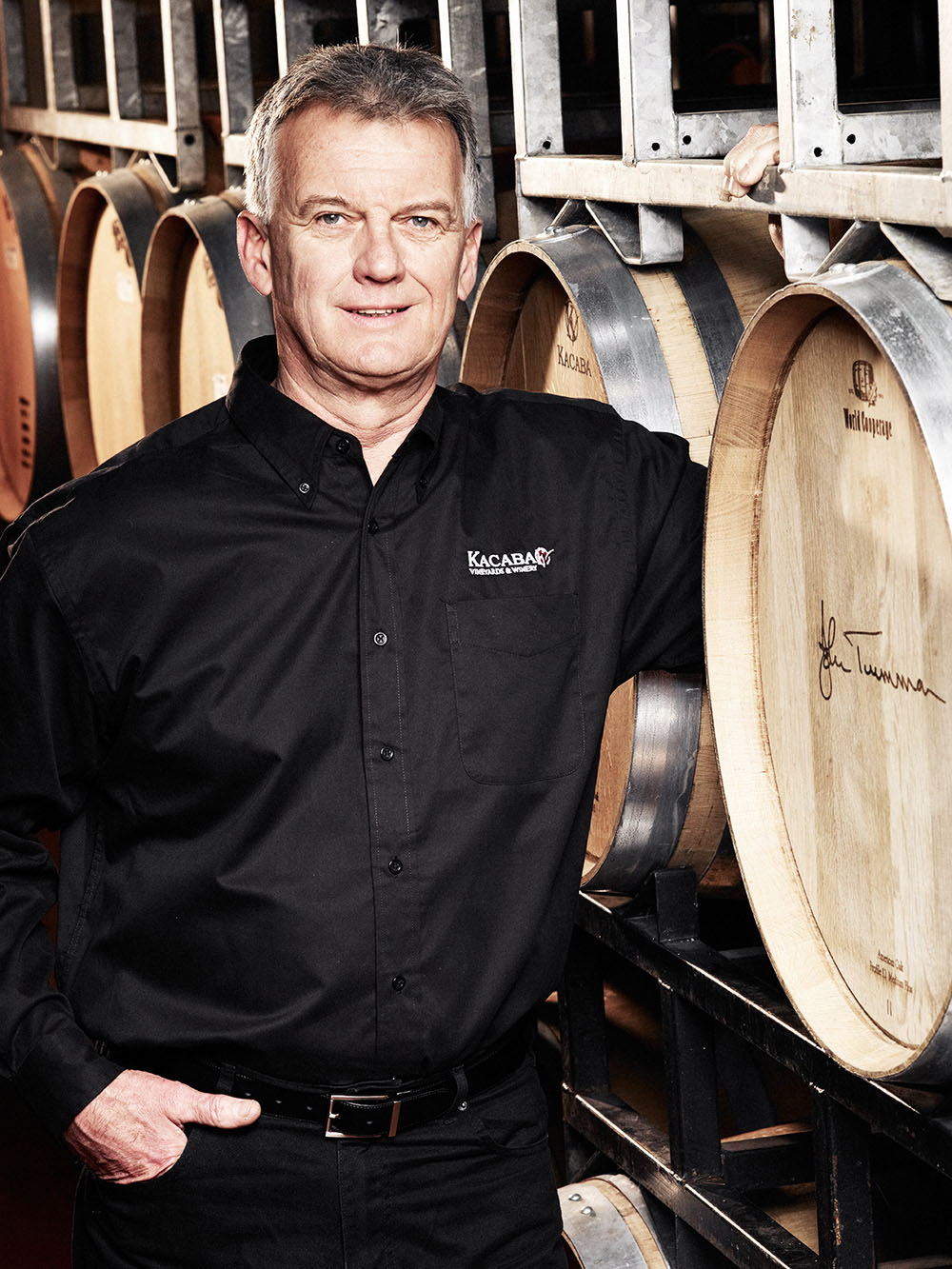
Henry of Pelham Estate Cabernet Merlot 2012 ($25)
I’m sure that you could hold onto a few bottles of this wine and enjoy them in a few years … but, if you’re like me, you’ll want to unlock the fruit flavours while they are young and vibrant. Expect rich cherry and strawberry on the nose, with the palate pushing into blackberry and currant. A little more depth brings a cocoa and wood-smoke note to the glass. Definitely a bottle I would expect to serve next to a medium-rare steak fresh off the grill.
Trius Red 2015 ($25)
This wine continues to be a benchmark for Bordeaux varietals in Ontario. It offers fantastic value and continues to be a staple for building a cellar. The nose on this bottle offers up raspberry and blackberry, with a nice cocoa note. The flavours match the nose with a nice smoky note on the finish. The tannins are firm but the fruit flavours still soar. An approachable wine that can be enjoyed immediately next to roasted or grilled red meats. But it will also age well in a cellar for 5–10 years.
Trius Red 2016 ($25)
This bottle checks all the boxes in terms of what is possible from well-made Cabernet Merlot in Ontario. Aromas of cassis, black cherry and wood smoke. The flavours offer ripe and juicy cherry and raspberry. Going even deeper into the glass, you will find baking spice, vanilla and cocoa. Every note in this luscious wine compliments the others and, in spite of the very ripe fruit flavours, there is nice restraint and great acidity on the finish, reminding us that this is, in fact, a cool-climate wine.
Rockway Vineyards Reserve Meritage 2012 ($20)
The aromas are stewed meat, wood smoke and cassis. Even though this wine has the hot 2012 summer firmly in the rear-view mirror, the fruit is still youthful and vibrant. On the palate, even more fruit reveals itself with cherry, cassis and blueberry. The tannins still grip a bit on the finish, letting you know that it won’t be a problem if you decide to hold this for another 5 years.
Creekside Estate Winery Laura’s Red 2015 ($22)
Full disclosure: there is only about 9% Syrah in this blend — the remainder is 37% Merlot, 28% Cabernet Sauvignon and 26% Cabernet Franc. But I still feel that, at its heart, this wine is a Bordeaux-style blend. There is a nice meaty aroma layered over cassis and blackberry. The depth of the flavours in this wine are just incredible: black currant, blackberry, plum, black liquorice and a slight hint of spice. The tannins are still a little grippy on the way out, but this should settle down shortly after opening. You can expect this wine to go 5–7 years in a cellar.
The Foreign Affair Dream 2015 ($30)
As with many of the wines from the Foreign Affair, 15% of the juice in this one comes from grapes that were dried after harvest (appassimento). As a result, it’s no surprise that everything about this wine is a little pumped up. The aromas offer nicely concentrated cocoa and raspberry jam. The raspberry, cassis and blackberry fruit open up with nice intensity and weight. The tannins are soft and this wine is ready to enjoy now. You can expect this one to cellar for 4–6 years.
Inniskillin Meritage 2015 ($20)
There is a slight red-pepper-jelly note circling raspberry on the nose — Cabernet Franc has proudly announced its presence in this bottle! On the palate, the savoury note is nicely restrained and replaced with raspberry, blackberry and a cocoa note. The tannins are soft but still robust should you decide to hold onto this wine for 5–7 years.
Niagara College Teaching Winery Meritage 2012 ($25)
A blend of 45% Cabernet Franc, 37% Merlot and 18% Cabernet Sauvignon. Given the age of this wine, it is still clinging to its youth, but it’s starting to soften and it’s so smooth on the finish. The aromas and flavours offer raspberry and blackberry, and a nice cocoa note caresses the fruit. A bit of wood smoke makes an appearance on the soft velvet finish.
Ravine Vineyard Sand and Gravel Redcoat 2014 ($20)
This is probably the most “French” of all the wines that I tasted. There is a barnyard note on the nose, but it is perfectly restrained and well layered over cassis. There is something about the funky note on the nose that makes you want to dive head first into the glass and get lost in the blueberry, cassis and blackberry, with a cocoa note on the finish. This wine is approachable from the onset, but should develop nicely over the next 5–7 years.
Thirty Bench Winemaker’s Blend Red 2015 ($25)
Pure cassis on the nose and on the palate. It’s rich, it’s dark and there is a nice note of wood smoke and spice that climbs out from under the avalanche of black fruit bit by bit as you get deeper into the glass. An approachable and easy-drinking wine, but there is enough structure to the tannins and acid that it could easily sit in your cellar for 8– 10 years.
Organized Crime Pipe Down 2016 ($22)
My favourite wine out of all the wines I tried. There are so many great wines in this article, but this one managed to climb to the top of the hill. A blend of Cabernet Sauvignon, Merlot, Cabernet Franc and Petit Verdot. There is a trifecta of elements that makes this wine so good: fruit, tannins and acidity. The aromas and flavours are cherry, wild strawberry and cassis. There is a slight vanilla and cocoa note that brings up the finish. This is one of those wines that you could pair with food, but in my house, you’re likely to only find it paired with a second glass.
PondView Estate Winery Cabernet Merlot Reserve 2015 ($23)
There is something a little meaty and a little smoky that climbs out of the glass here. A short swirl of the wine knocks some fruit out from under the campfire cookout aromas. You will find cassis, blackberry and plum on the palate. The tannins are still quite closed off and tight, so expect to put this wine in a decanter if you plan to drink it now, otherwise revisit this wine in a year or two. You can expect this wine to hold in a cellar for 7–10 years.
Weather Report Red 2013 ($29)
This new line from Stratus offers something in between their top offerings and the Wildass line that is frequently seen at Vintages. An unconventional blend, with Cab Franc, Cab Sauv and Merlot at its core, but there is also some Syrah, Viognier and Tempranillo in the mix. In tasting this wine, I was less concerned with the blend and more with the full-bodied, ripe fruit coming out of my glass. While this wine is accessible in its youth, and the tannins are well integrated, it is something that would benefit from a couple of years in a cellar to help soften the edges.
Stratus Weather Report Red 2014 ($29)
You could enjoy this bottle now — but, trust me, this wine will benefit from some time in a cellar to unlock its full potential and depth. There is vanilla and baking spice on the nose. On the palate, the ripe fruit pushes through and brings raspberry, cherry, blackberry, cassis and plum to the glass. The tannins are large but approachable. I think this wine would be best enjoyed young but, given the way this wine is structured, youth is relative — expect to wait until 2020 to really enjoy this wine.
Peninsula Ridge Meritage Reserve 2016 ($25)
A wine that requires some patience. It took two days for this wine to finally reveal to me what potential there was in the bottle, but it was worth the wait. You can expect to (eventually) find cherry, strawberry, blueberry, cassis and blackberry layered over baking spice and vanilla. The fruit is juicy and ripe, but there is some restraint in this bottle, which keeps the flavours from coming across as jammy. Anticipate this wine sitting in a cellar for at least 3 years before thinking of opening it without some serious time in a decanter. I anticipate it lasting 10 years or longer in a cellar.
Rockway Small Lot Meritage 2013 ($25)
Dark, heavy and brooding. The campfire smoke and beefy note announces itself without apology as it climbs out of the glass. On the palate, the fruit is blueberry, blackberry and plum. This wine is so closed off and tight right now that it requires quite a bit of time in a decanter to unlock the rich, dark fruit notes. The tannins are already silky smooth on the finish, but with a few years in a cellar, they should soften and bring some more balance.
Ravine Meritage 2016 ($28)
A blend of 45% Cabernet Sauvignon, 20% Cabernet Franc and 35% Merlot. I have a soft spot in my heart for milk chocolate — and the aroma of this wine smells just like that. The flavours here offer a symphony of fruit with blueberry, plum, blackberry and Saskatoon berry (if you’ve never had one, this wine definitely brings their flavour to the glass). The tannins are still gripping on the finish so I would stow this wine away for a year or two before enjoying. Expect this bottle to hold for 7–10 years.
Jackson-Triggs Reserve Meritage 2015 ($25)
With aromas of charred wood and coffee jumping out of the glass, it took a fair bit of coaxing to get this wine to reveal the fruit hiding beneath. Expect to store in a cellar for 2–3 years, even if you plan on enjoying this wine while it’s young. With some patience, doing so will reveal cassis, blackberry and blueberry. That being said, if you open this wine now, expect to find mocha, and smoke front and centre. Cellar this bottle for 7–10 years.



